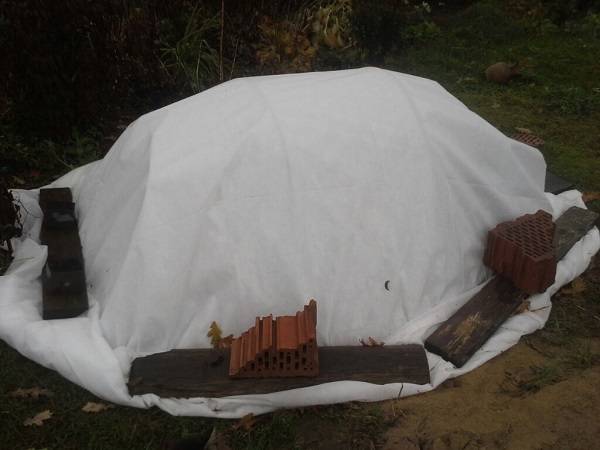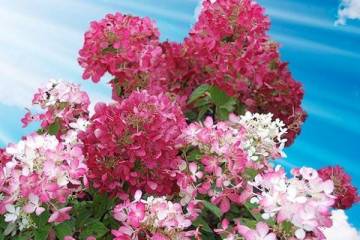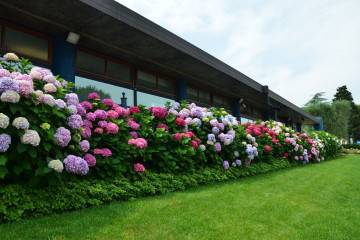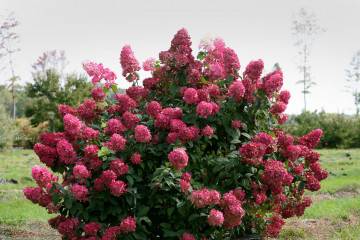Large-leaved or broad-leaved hydrangea - planting and care in the open field
Content:
Large-leaved hydrangea, or large-leaved, is a luxurious shrub, adorned with many beautiful flowers that form a cap shape. The name is translated from Greek as “yearning for water”. The color of the inflorescences captivates with its variety. There are purple, blue, crimson, white, blue and deep crimson.
Large-leaved or broad-leaved hydrangea - planting and care in the open field
Broad-leaved hydrangea is an excellent choice for decorating the surrounding space. The growing process is not easy. The plant is demanding to care for, especially outdoors. The conditions should be chosen carefully. For this reason, in Siberia, in the Urals, it is recommended to grow at home. Not suitable for a summer residence, a garden. This is an exclusively ornamental plant. In the central zone of the country, including the Moscow region, preference is given to tree-like and paniculate species.
The origin and appearance of the plant
The homeland of this exotic beauty is Japan. Three centuries ago, she first came to France, and from there to other European countries.
The shrub belongs to the hydrangea family of the same name. Reaches 2 m with proper care. At home, the maximum height of an adult plant is no more than 60 cm.
It begins to bloom from the first days of June to autumn. The flowers are arranged in spherical inflorescences. They can also be in the shape of an umbrella or panicle. The fruit of the bush is a seed capsule with 2 to 5 divisions inside.
A basic requirement for successful outdoor cultivation is proper, proper care in winter. After all, as you know, in the homeland of the shrub, it is warm enough and it is used to the sun and freezing temperatures. However, over time, it adapted, so it can tolerate low temperatures - up to -25 degrees.
Hydrangea has been used in landscaping for many years. There are about 60 species, each of which has its own features and characteristics of care. For simplicity, all types were divided into 5 groups:
- large-leaved;
- paniculate;
- petiolate;
- tree-like;
- ground cover.
Types and varieties
There are up to 80 large-leaved varieties. Some can only grow at home, others - in the garden. Below are those that are very popular with flower growers.
Macrophile
Hydrangea Macrophylla is a tall shrub that grows up to 4 m. At the beginning of the 19th century, the plant came to the European continent from China. At the moment, breeders have already bred more than 100 hybrids. Most of them are houseplants that are not hardy.
This type of hydrangea has ball-shaped inflorescences. The acidity of the soil affects the color of the flowers. It can range from light, white tones to rich purples. Flowering continues throughout the summer. In winter, it can only be kept in a greenhouse.
Earley Pink
Early Pink hydrangea is one of the latest in large-leaved varieties. She has a beautiful pink bloom. An adult shrub is up to 1 meter high.A hardy variety, actively used for bouquets (dry). Airlie Pink hydrangea can be planted in open ground when real spring comes and there is no threat of frost return.
Countess Kossel
The broadleaf plant is very attractive. Pastel pink flowers look graceful and touching. By planting such a plant alone or in a group, you can add a touch of romance style to the garden. A thin border around the edges makes the flower even more touching. Shelter is required for the winter. A good variety for the garden.
Hydrangea Fire Red
Large-flowered variety with inflorescences 15-20 cm in diameter. There are pink, blue, white flowers. In one season, they can change color several times. Propagated at room temperature in a vegetative way.
Earley Rose
Early Rose is another variety with large leaf blades. It does not tolerate winter in the Russian climate. For this reason, they are engaged in breeding Earley Rose at home. A half-shaded place, closed from drafts and wind, will do.
General Vomtess De Vibrayi
It is a tree variety that grows faster than others. In a few days, a gorgeous shrub with a dense crown is obtained from a simple cuttings. Flowering begins in mid-July and ends in early September. The hydrangea has large, blue inflorescences. Unlike most, it is a winter-hardy variety.
It should also be noted the varieties Romance and Joy. Their advantage is double pink flowers. There is also the Blue Bird variety, but it is rarely found in Russian garden plots. It has deep blue inflorescences. Hydrangea Endless summer blooms twice a season. This is the most real miracle among their own kind in breeding.
Transplant after purchase in open ground
Broad-leaved hydrangea, including the Macrophilia hydrangea, which are planted and nurtured in the open field according to certain rules, are heat-loving plants. And this is natural, since their homeland is a country with a warm climate. Several factors influence the development of plants:
- ambient temperature;
- illumination;
- soil (composition);
- humidity level;
- top dressing;
- watering.
In short, hydrangea must be properly cared for.
Choosing the best place
The plant is thermophilic, but does not like much direct sunlight. It is enough for him to be under the sun 6 hours a day to grow and develop normally. For the same reason, it should not be planted under open trees. There is a high probability of overdrying from constant sun. Shadows should also be in moderation. Otherwise, flowering can not wait.
The soil should be well warmed up, above +10 degrees. Otherwise, the kidneys will not open. The acidity of the soil is low or medium. The composition should not contain lime so that the root system does not rot.
Young shrubs necessarily protect from frost possible in spring, as well as gusts of wind. But the place must be ventilated. Often, the landing site is along the fence (like a "hedge") or directly next to the house.
Step-by-step planting process
A step-by-step description of the process of transplanting a hydrangea from a small pot into open ground:
- Prepare the soil in advance: apply top dressing, dig in, remove weeds.
- With the onset of spring, a 30 × 30 cm planting pit is dug, leaving a distance of 1 m between plantings.
- During planting, the bottom of the pit is lined with peat, and minerals and organic matter are added.
- For seedlings, the roots are slightly shortened and immediately dipped in a mixture of clay and earth.
- The planting hole is slightly filled with water and the cutting is dipped into it, positioning so that the neck of the root is above the surface of the soil.
- Fall asleep with earth and carry out mulching.Compost, humus or peat are used as mulch. Cover with foil on top.
The first young shoots appear, as a rule, after 30 days. The film is then no longer needed, it is removed. Loosening, weed cleaning, and watering are carried out regularly.
Reproduction of large-leaved hydrangea
There are two ways of propagation - cuttings and seeds.
Propagation by cuttings
It is important to properly prepare the cuttings. This is done at the time of spring pruning of the bush:
- cut shoots early in the morning (always with buds);
- each is divided into parts, on which several sheets and buds should be present;
- cuttings are placed in a solution of water with a stimulant for the growth of the root system;
- after 3 hours, they are placed in planting containers, watered a little and covered with jars or plastic bottles on top.
Roots should appear after 30 days.
Growing from seeds
In order for this breeding method to give a good result in the form of a lush, healthy shrub, you should carefully consider the choice of planting material. It is better to purchase it from trusted sellers from well-known manufacturers.
Carefully prepare the soil by digging, removing weeds and other debris, including insect larvae. Branches, compost, grass are introduced into the planting pit, sprinkled with a mixture of soil and humus. Level the soil surface with a rake. Spill well with water (hot). At the very end, cover with foil for 3 days so that the soil warms up properly. After this time, the seeds are placed on the surface of the soil, pressing a little. Moderate watering is carried out. Cover again.
Large-leaved hydrangea care
For hydrangea, large-leaved care is no less important than planting. It must be systematic. Particular attention is paid to moistening the soil, fertilizing.
Water for irrigation should be soft. It should be free of chlorine and impurities. The most ideal option is water collected after rain or settled for several days. One adult shrub requires 2 buckets of water.
In one season, hydrangea is fed no more than 4 times. The plant loves potassium, nitrogen and phosphorus. These trace elements help it bloom faster. During the flowering period, fertilizing with nitrogen is added once every 14 days. From the age of 4, rejuvenating pruning is carried out to preserve decorativeness.
Preparing for winter
The dormant period is an important stage for the further growth and development of the plant. In autumn, watering and feeding are reduced. Leaves are removed from the plant, and the branches are tied into bunches. High hilling is carried out and a frame is created for the material intended to shelter the plant for the winter. In open ground in cold winter, the shrub is completely covered with snow.
Large-leaved hydrangea requires both proper planting and proper care for it. Only in this case will it delight with its flowering for a long time from year to year.




















